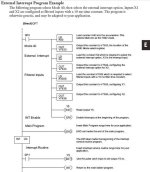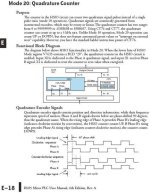Good morning to everyone i would like to ask for some help!
I have created a software for the automation of a milling machine! Its a school project where we have to control the position of the mill axis. I am using a Plc DL05 with a C-more micro panel.
I have created the software for the position control of the axes using the Quadrature Encoder Mode 40 of the plc manual as I am using a quadrature encoder for controlling the position. the counter i am using its the ct76 counter.
In particular my PLC has to control 3 output variables : Y0 , the motor power on and off, Y1, command for the relays to invert the direction of the motor, and Y2 which is a command that will attach,detach a magnetic friction that is between the motor and the axis (in the case the operator want to move the mill axes manually).
My software seems to work well except for a little thing i would like to ask help! In my application i would like to use some time delay between the time my motor is powered on and the friction is attached, as well between the time my motor is powered off and the friction is detached.
So i would like something like this: when Y0 is SET , there is like 5 secods delay then the Y2 is SET,
and viceversa when i want to stop everything, i RST the Y2 and then after some seconds i RST the Y0.
How this can be done?
I have tried to use TMR boxes but this seems to affect the counters and so the quadrature counting won't work well. Has anyone some ideas or advice for me??
I attach you here my software : the "milling.zip" its my original software that works except from the fact that the Y0 and Y2 outputs will be turning on and off together!
the second attachment ("timers") its my trial to use timers for obtaining a delay . I don't understand what is wrong and why i cannot obtain the delay between the two outputs!
please can anyone help me? thank you so much!
I have created a software for the automation of a milling machine! Its a school project where we have to control the position of the mill axis. I am using a Plc DL05 with a C-more micro panel.
I have created the software for the position control of the axes using the Quadrature Encoder Mode 40 of the plc manual as I am using a quadrature encoder for controlling the position. the counter i am using its the ct76 counter.
In particular my PLC has to control 3 output variables : Y0 , the motor power on and off, Y1, command for the relays to invert the direction of the motor, and Y2 which is a command that will attach,detach a magnetic friction that is between the motor and the axis (in the case the operator want to move the mill axes manually).
My software seems to work well except for a little thing i would like to ask help! In my application i would like to use some time delay between the time my motor is powered on and the friction is attached, as well between the time my motor is powered off and the friction is detached.
So i would like something like this: when Y0 is SET , there is like 5 secods delay then the Y2 is SET,
and viceversa when i want to stop everything, i RST the Y2 and then after some seconds i RST the Y0.
How this can be done?
I have tried to use TMR boxes but this seems to affect the counters and so the quadrature counting won't work well. Has anyone some ideas or advice for me??
I attach you here my software : the "milling.zip" its my original software that works except from the fact that the Y0 and Y2 outputs will be turning on and off together!
the second attachment ("timers") its my trial to use timers for obtaining a delay . I don't understand what is wrong and why i cannot obtain the delay between the two outputs!
please can anyone help me? thank you so much!







